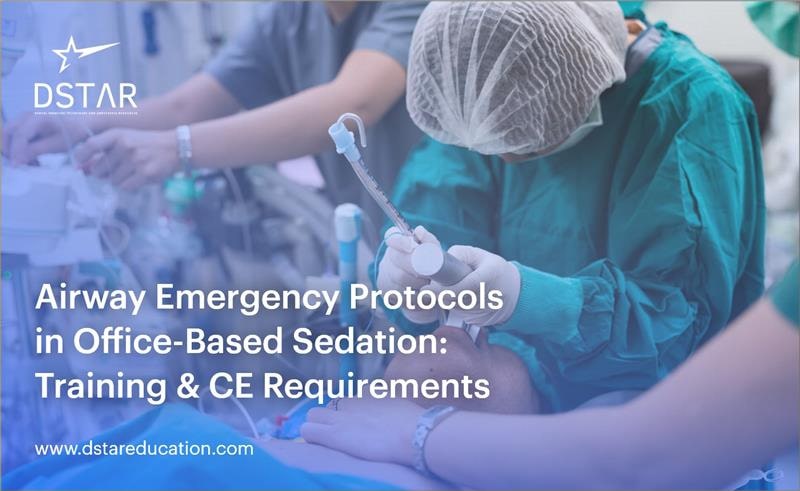Dental professionals who hold an office-based anesthesia permit in Texas bear legal and clinical responsibility for managing any complication that arises during sedation. Among the most critical of these is the emergency airway scenario. This event demands rapid decision-making, flawless technique, and strict compliance with Texas State Board of Dental Examiners (TSBDE) regulations.
Whether delivering minimal, moderate, or deep sedation, all licensed providers must demonstrate proficiency in emergency airway management, reinforced by targeted continuing education and scenario-based training.
This guide outlines the airway emergency protocols required for dental offices in Texas, including a breakdown of basic airway management standards, certification mandates, and PALS CE hours required for those treating pediatric patients.
Understand the Risk: Why Emergency Airway Management Training Is Non-Negotiable
In dental sedation, the airway remains the most vulnerable system affected by anesthetic agents. Sedation reduces airway protective reflexes, increases the risk of obstruction, and may compromise oxygenation.
Without a prompt and skilled response, an emergency airway event can escalate to hypoxia, permanent brain injury, or death within minutes.
TSBDE requires all practitioners who hold an office-based anesthesia permit in Texas to demonstrate and maintain competency in emergency airway management. The standard is not simply knowing the theory; it’s about proving technical readiness to intervene in both adult and pediatric scenarios.
Also Read: Airway Adjuncts Basics
Components of Basic Airway Management in Dental Sedation
Basic airway management encompasses several first-line techniques and tools required before advancing to invasive interventions. Dentists providing sedation must be proficient in:
- Head tilt–chin lift and jaw thrust maneuvers
- Use of oropharyngeal and nasopharyngeal airways
- Bag-valve-mask ventilation (BVM)
- Pulse oximetry and capnography monitoring
- Use of supplemental oxygen and suction
These foundational skills are mandatory for all levels of sedation permits and form the basis of any escalation pathway in an emergency airway event.
Also Read: Choose the Right Dental Sedation Re-Certification Platform?
Emergency Airway Equipment Requirements in Texas Offices
To maintain an Office-based anesthesia permit in Texas, dental practices must stock and routinely inspect all airway management equipment. As per TSBDE and ADA guidelines, required equipment includes:
- Oral and nasal airways (multiple sizes)
- Oxygen delivery systems with backup tanks
- Ambu bag (manual resuscitator)
- Suction with rigid and flexible catheters
- Capnography monitor
- Pulse oximeter
- EpiPen and reversal agents (e.g., naloxone, flumazenil)
- Portable AED with pediatric and adult pads
All devices must be tested, logged, and checked for expiration as part of the facility’s monthly inspection protocol.
Pediatric Airway Management and the Role of PALS CE Hours
Any dentist who provides sedation for children must complete PALS CE hours to satisfy both state and national standards. The TSBDE requires Pediatric Advanced Life Support (PALS) for:
- Pediatric minimal, moderate, or deep sedation providers
- Emergency protocol renewal for pediatric patients
- Level 3 or Level 4 sedation permits and the involvement of patients under age 13
PALS training includes simulation of emergency airway management in infants and children, with emphasis on age-appropriate tools, airway sizing, and medication calculation. As per TSBDE rules, providers must retain certificates of PALS training and log the number of PALS CE hours completed each renewal cycle.
Emergency Airway Drills: Internal Protocols for Office Teams
CE hours and certifications alone are insufficient without applied practice. Offices with an Office-based anesthesia permit in Texas must implement in-house drills and training sessions to keep staff prepared for emergency airway scenarios.
Recommended emergency drills include:
- BVM ventilation and oxygen failure simulations
- Mock codes for airway obstruction and respiratory arrest
- AED use with pediatric and adult mannequins
- Drug delivery scenarios (epinephrine, naloxone, flumazenil)
The staff must log each training event with the date, attendees, equipment used, and outcomes. TSBDE inspectors may request these logs during office inspections.
Continuing Education Requirements for Sedation Providers
In Texas, dental providers with sedation permits must complete CE hours in both airway management and medical emergency response. As of 2025, CE standards include:
- 16 hours every 2 years for moderate sedation (Level 3)
- 24 hours every 2 years for deep sedation/general anesthesia (Level 4)
- Mandatory emergency airway management components
- Proof of BLS, ACLS, and PALS CE hours as applicable
Courses must be TSBDE-approved, and dentists must retain certificates for each completed course. Failure to provide proof may result in permit suspension.
What Inspectors Evaluate During Permit Renewal or Surprise Visits
TSBDE inspectors often request evidence of basic airway management competency during audits. Items commonly reviewed include:
- Logs of expired/replaced airway equipment
- CE transcripts reflecting PALS CE hours
- Staff rosters with BLS, ACLS, and PALS certifications
- In-office training documentation
- Anesthesia incident reports, if any
Dentists who cannot verify active compliance risk probation, penalties, or full permit revocation. Every clinical staff member must know their role during an emergency airway event and respond within protocol. We also have a list for Texas dental license renewal requirements.
Why Office-Based Emergency Readiness Saves Lives
Every year, adverse events in dental offices stem not from complex medical pathology but from a delayed or inadequate emergency airway management response. That risk is preventable with consistent continuing education, proactive inventory management, and targeted emergency event practice.
Whether treating adults or children, dentists must recognize that understanding and management of the airway is critical to safe sedation practices. The TSBDE holds providers accountable not only for dental sedation education outcomes but also for their preparedness before the patient ever enters the operatory. The Texas Office-based anesthesia permit is not simply a formality; it is a contract of clinical readiness.
Conclusion
Airway emergencies in dental sedation are rare but potentially fatal. The best protection against catastrophe is a prepared, educated team equipped with the right tools, training, and certifications. By mastering basic airway management, staying current on PALS CE hours, and fulfilling all requirements tied to the Texas Office-based anesthesia permit, dental professionals uphold the standard of care required by law and expected by patients.
Failure to prepare is preparation to fail. And in sedation dentistry, failure can be irreversible.
References
- Texas State Board of Dental Examiners – https://tsbde.texas.gov
- Texas Administrative Code Title 22, Part 5 – https://www.sos.texas.gov
- American Dental Association – Guidelines for Sedation and Anesthesia
- American Heart Association – ACLS & PALS Certifications
- American Academy of Pediatric Dentistry – Sedation & Airway Guidelines
- American Society of Anesthesiologists – Basic Airway Management Protocols
- Journal of Dental Anesthesia and Pain Medicine – https://www.jdapm.org
- National Board for Certification in Dental Anesthesia – Continuing Education Requirements
- OSHA Medical Emergency Standards – https://www.osha.gov
- Texas CE Course Accreditation Providers – TSBDE-Approved List
 Take Free TSBDE Anesthesia Jurisprudence Practice Exam Now!
Take Free TSBDE Anesthesia Jurisprudence Practice Exam Now!












